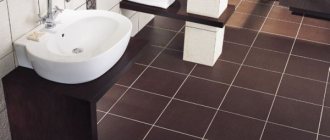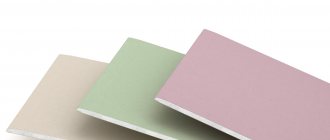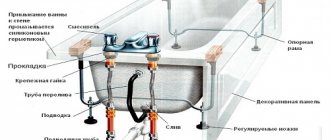Ceramic tiles are one of the most practical facing materials for the bathroom. Its advantages include ease of cleaning, protection from mold, resistance to wear and chemicals, while its disadvantages include difficulties in installation, dismantling and drilling holes for shelves, pipes and plumbing fixtures.
Before drilling tiles on the bathroom wall, you need to prepare the surface and firmly fix the drill: this will avoid accidental impacts and increase work efficiency.
Basic principles of drilling ceramic tiles
When working with ceramic tiles, it is very important to take into account its parameters (thickness, length). The drilling process must be treated with extreme care and precision. Important factors to take into account include:
- overheating of the tile and drill is not allowed, as this may cause the ceramic to split;
- it is necessary to cool the working surface by regularly spraying with water;
- the pressure on the mechanism should be chosen optimally, not too strong, but not too low. In the first case, the tile will probably break, in the other, it will not be possible to drill a hole;
- When drilling holes in tiles, reverse mode is unacceptable. The rotation of the drill should be leisurely and strictly in a clockwise direction;
- If a hole is made in a seam, care must be taken. There is no protective layer at the edge of the ceramic tile, so the center of the hole must be located strictly in the middle of the seam.
It is important to drill the tiles correctly so that they do not crack.
Working with a crown
The tubular product costs a lot, but it will definitely complete at least one hole and will serve well later. Despite many positive qualities, it is important to properly handle the element in order to extend its service life.
Application is possible only at low speeds, otherwise the cutting part will quickly wear out. Overheating the bit can cause it to burst, rendering the drill useless. To reduce the heating level, the crown is periodically lowered with its edge into water.
Diamond crown
One-time actions can be performed with a one-time model made of pobedit with cutting teeth. Unlike its diamond counterpart, the product will not withstand more than 20 drillings. The power of this model allows you to make a good place for a sewer pipe, but you must act very carefully so that the teeth do not make the edges of the cut-out space chipped or uneven.
When working with a crown, markings are first applied, the nozzle is secured and the coating is drilled along the front side. If the element used is in good condition, then it will take literally 2-5 minutes to create a recess.
Choosing a tool
Ceramic tile coating has been described as a reliable and moisture-resistant material. It is used for walls and floors in the bathroom and kitchen. The tiles perfectly protect walls from moisture.
An example of finishing a bathroom with ceramic tiles
Thanks to the color palette, it is easy to choose tiles to suit any apartment design.
Bathroom decoration with beige ceramic tiles
Since the hardness of ceramic tiles varies, drilling can be done with different tools:
- a hammer drill with a “no impact” drilling mode;
- hand drill;
- electric drill;
- corded or cordless screwdriver.
A hammer drill is used very often in repairs. Its main purpose is to drill holes in a variety of materials.
Hammer
Hammer diagram
Before you start drilling ceramic tiles, you need to determine the work procedure.
- Usually, on the front side of the tool there is a mark with a picture of a drill. It is necessary to turn the toggle switch to this position.
- When performing work, it is forbidden to press the hammer drill trigger with force. There should be no extraneous hum, shaking, or knocking.
hammer drill
How to insert a drill into a hammer drill
A hand drill is a mechanism of the simplest design, consisting of a frame and a chuck. To make holes in the tile, a drill is inserted into the chuck, and the device begins to work. It operates slowly, and you need to strain to make a hole. The advantage of the device is its independence from electricity. A hand drill is most often used to make small holes.
Hand drill (brace)
Electric drill - cope with the task in a few seconds. Operates from a 220 W network. The tool drills holes in ceramic tiles at low speeds using a light feed. The work area should be periodically cooled with water.
Electric drill
How to choose a drill
Screwdriver - There are two types. In order to make holes in the tiles, it is necessary to use a screwdriver (preferably cordless) at a speed not exceeding 900 rpm. A mains-powered device must also have a low-speed operating mode.
Screwdriver
screwdriver
General rules
Under the general name tiles lies a wide range of finishing materials with very different properties. First of all, you should pay attention to the presence of glaze and firing temperature. If the finishing material was fired at a high temperature, 1200˚C or higher, then it has increased strength and will be more difficult to verify. This applies to porcelain stoneware and Metlakh tiles.
In any case, adhere to the following settings:
- The rotation speed of the drill should not exceed 800 rpm. Exceeding this speed has an almost linear effect on the probability of tile breakage;
- Use only special drills;
- Don't try too hard. The pressure on the tool should be even, without jerking or impact;
- “Wet drilling” is preferable to dry drilling, as it avoids local overheating.
- When drilling, be sure to place the tiles on a flat, horizontal surface. The best option is to lay a piece of drywall or plywood.
- Always drill from the front side of the tile. It is easier to center the drill on the reverse side, but when exiting there will almost always be chips in the glaze.
Compliance with the requirements of only these six points guarantees an excellent result by 90%.
Drilling large diameter holes
When drilling holes for water pipes, a socket or a switch, where the diameter is more than 20 mm, use a ballerina or crowns.
Examples of unsuccessful drilling of tiles for electrical outlets
A crown is a tubular type instrument with a special (diamond) coating. The fairly high price of the cutter is offset by time savings and drilling quality. Using diamond core bits, it is possible to make holes with a diameter of up to 160 mm.
Drilling with cooling
Ballerina is a drill with a sharp tip, similar to a spear, on the lower part of which a holder is attached. Another drill of the same type is attached to it. By moving the bracket, you can set the diameter of the intended hole.
Drilling with a crown
Securing the crown
The drilling technique is similar to drilling for a dowel. The cutter is placed exactly parallel to the tile, so that when it goes deeper, the drill begins to evenly cut the ceramic around the circumference. Sideways movements are not allowed.
Drilling porcelain stoneware
Drilling with a diamond core involves the process of operating the drill at high speeds. Overheating in this case cannot be avoided; in order to avoid heating and burning of the crown, it is necessary to moisten the device with water. Of course, you can drill ceramics “dry”, but only at low speed.
If the cutter does not have diamond protection, do not use the “dry” method. Moreover, using water when drilling speeds up the process.
Drilling by ballerina
Working as a ballerina begins with setting the desired diametrical size. It is necessary to hold the tile and start drilling strictly at low speed. When working, it is recommended to use safety glasses to prevent waste particles from getting into your eyes.
Drilling with a circular ballerina drill
The drill must be held accurately, without changing position or tilting. Don’t forget to place a container of water nearby; when drilling ceramics with a ballerina, you also need it. The main thing is not to rush, act with caution so as not to damage the tiles.
The hole in the tile is cut by a ballerina
Advice! Drilling large diameters in tiles requires some skill. Therefore, it would be a good idea to practice on old tile scraps. Such training will allow you to “get your teeth into” and gain some experience, albeit a little!
Drill size
There are differences between drills for tiles and those used for concrete, wood or metal. They have a sufficient level of strength. They are divided into several groups:
- tiled, capable of making a hole from 12 to 18 mm;
- diamond-coated nozzle, suitable for making holes of any size;
- carbide, suitable for punctures less than 15 mm, differs in sharpening of the tip;
- a pobedit drill, which has a long service life, makes a puncture for dowels and other small holes;
- “ballerina” drills a hole up to 10 cm;
- circular drill with protective grid.
To work with tiles, a core drill is most often used. Its working part is coated with diamond. It must be cooled during operation to prevent overheating. There is also a core-type drill, at the end of which there are teeth made of hard alloys. It is capable of drilling only a small number of holes, and the quality of the hole leaves much to be desired.
Ceramic tiles are a common finishing material used for indoor installation. Therefore, it is important to know all the subtleties and nuances of its processing. You can use both traditional and alternative methods, the main thing is to be careful, follow safety precautions, and use only the right tool. Only in this case the work will be completed correctly.
How else can you drill into tiles?
There is another technique that can be used to make a large hole in a tile that is not yet glued to the wall. To do this, as mentioned earlier, the ceramics are immersed in a basin of water. After a while, take it out and wipe it. Mark the diameter of the desired circle on the tile (draw a circle). Holes are drilled around the perimeter so that the center of the circle can be broken off. Therefore, the holes must be drilled close to each other. The resulting hole in the tile is ready, you can insert it into the pipe. The edges turn out uneven, we process them with a file.
The order of drilling small holes around the circumference
Gently knock out the center with a hammer
File uneven edges
The method is applicable if you don’t have a ballerina or a cutter at hand.
Advantages:
- The tile can be prepared in advance for the hole drilling process.
- soaked tiles significantly reduce the risk of splitting.
Little tricks for drilling tiles
Like any business, drilling has its own tricks and secrets, knowledge of which will help make the task easier and get the job done efficiently:
- You should not make holes close to the edge of the tile, this can cause it to split;
- if special drills are not available, you can use ordinary ones for metal. In this case, you can drill only at low speeds;
- if the drilled hole for the dowel has a large radius, you can insert an ordinary wooden chopper into it;
- To reduce contamination from drilling, you need to place a scoop directly under the work area. For installation of a screen under a bathtub, read the link.
Using a hacksaw and string to cut tiles
Using a tile glass cutter and pliers for making a hole in a tile
Cuttings with cutting disc
The tile must be fixed on a soft, thick base, for example, on a wooden block. The reason is that the disc will come out from the back side by 5-7 mm. With this immersion depth, it is possible to trim the edges of the hole more accurately.
The gap between each slot is 3-4 mm.
The cuts are made crosswise. In this case, most of the jumpers will fall off on their own. The protrusions remaining at the edges are broken off with wire cutters or pliers.
The edges do not need to be processed if they will be covered with decorative panels or overlays.











